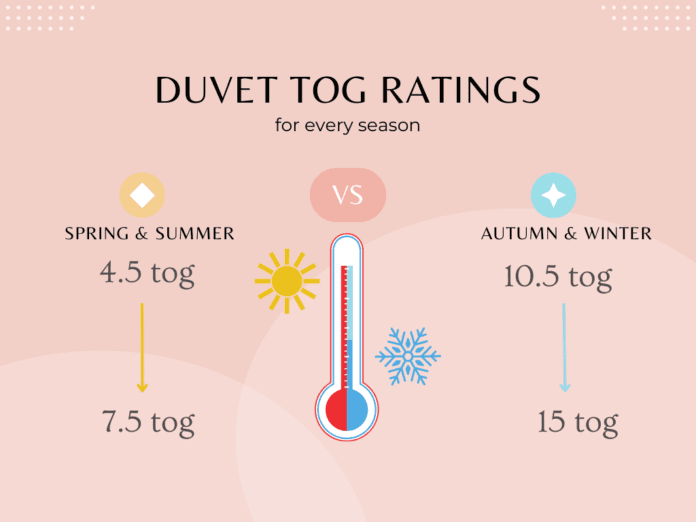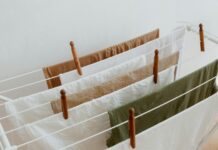As March heralds the start of spring and an increase in temperature, some people may be considering swapping out their thick winter bedding for lighter ones.
However, many people are unaware of just how important a role your duvet plays in maintaining a healthy night’s sleep. Recent research suggests that thermal comfort is just as important for quality sleep throughout the night, as other ambient conditions such as darkness and silence (Durmuş et al. 2022).
With this in mind, sleep experts at Bed Kingdom have outlined the ideal duvet for each season and how to choose the right one for year-round quality sleep.
What exactly is a duvet tog rating?
Duvets are often classified by their tog rating, and a common misconception is that this is a measure of their thickness. However, tog actually stands for ‘thermal overall grade,’ and is a measure of how effectively a material traps heat.
With duvets, tog ratings range between 1 to 15, with those on the low end of the scale tending to be more lightweight and cooler, while those on the high end tending to be heavier and more insulating.
Different tog ratings provide different degrees of warmth, so it is important to consider all the relevant factors, including sensitivity to heat or cold, bedroom insulation, and the age of the person using the duvet before making a choice, especially as duvet purchases are usually less frequent than other bedding purchases.
The recommended duvet tog ratings for each season are as follows:
Spring: 7 – 10.5 tog
Summer: 1 – 4.5 tog
Autumn: 7 – 10.5 tog
Winter: 12 – 15 tog
Having a duvet that keeps your body at the appropriate temperature throughout each season can significantly improve one’s sleep quality, leading to improved physical health, mental acuity, mood, and productivity throughout the day.
Do I need more than one type of duvet?
For many people, it is unfeasible to own a separate duvet for each season due to storage and financial constraints. However, if possible, we recommend having at least two separate duvets to ensure optimum sleep conditions as temperatures change throughout the year.
A duvet with a tog rating between 4.5 and 7.5 is recommended for the warmer spring and summer months, while a second duvet with a tog rating between 10.5 and 15 would be the best choice for the colder autumn and winter months.
Having two duvets allows you to pair them together should temperatures drop really low. A cooler 4.5 tog duvet and a warmer 9 tog duvet can both be layered inside your duvet cover, to essentially create a third 13.5 tog duvet for those colder winter nights.
What is the best year-round duvet?
Duvets with a 10.5 tog rating are a great year-round option for those who can’t afford multiple duvets or do not wish to swap out their duvets frequently. A 10.5 tog duvet should allow most adults to maintain a consistent sleeping temperature throughout the year, provided they aren’t particularly susceptible to the cold or don’t tend to overheat in bed.
Factors to consider when buying a duvet
Some additional relevant factors to consider when purchasing a duvet are outlined below:
- Bed Size
Buying a duvet the exact size of your bed might seem like the obvious thing to do. However, some people may require plenty of extra duvets to wrap up in, so it could make sense to get a duvet that is one size larger than your bed. If you share your bed with a partner, this can ensure plenty of room for both parties under the duvet, as well as being able to wrap it under yourself during the colder months to increase its insulating effect.
- Duvet Fillings
Duvets can either be filled with natural insulating materials such as duck or goose feather, or down, or made with synthetic materials such as polyester hollow fibre or microfibre.
Duvets made with feather or down tend to be more effective at trapping heat than synthetic alternatives, and need to be replaced less frequently as they are more durable. However, they do tend to be more expensive.
On the other hand, synthetic duvets made with hollow fibre or microfibre polyester, are a more functional choice for many as they are hypoallergenic and typically cheaper. They offer a more practical option for families as they are easier to wash and will air dry more quickly than natural materials. The moisture-wicking properties of polyester also enable you to stay cooler in the summer, when you are more likely to sweat during the night.
- Household temperature
The ambient temperature of your home is one factor to consider when selecting the right duvet for your needs. If you are conscious of increased energy costs during winter or your house gets particularly cold, you may want to opt for a duvet with a tog rating higher than 10.5, to ensure that you stay adequately warm once you get into bed.
- Age
Research shows that our ability to self-regulate body temperature changes as we get older. Children tend to get warmer in bed much more quickly than adults, while elderly people typically take the longest to get warm. As such, age should be considered while choosing a duvet.
Try to opt for a duvet below 10.5 tog for younger children and around 4 tog for toddlers and babies, to prevent them from overheating during the night. Duvets above 10.5 tog would be best for elderly people who are more likely to feel the cold during the night than younger adults.
Credit to https://www.bedkingdom.co.uk who published the above post.
Help keep news FREE for our readers
Supporting your local community newspaper/online news outlet is crucial now more than ever. If you believe in independent journalism, then consider making a valuable contribution by making a one-time or monthly donation. We operate in rural areas where providing unbiased news can be challenging. Read More About Supporting The West Wales Chronicle


























